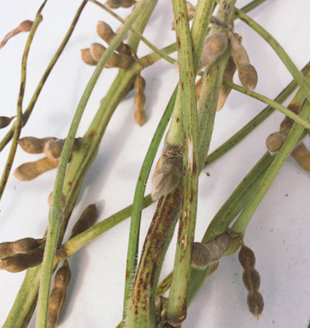
- Green Stem Disorder (GSD) is when mature pods are found on green stems.
- The causes of GSD are complex and not fully understood.
- Environmental stress during R4-R5 is a root cause common factor.
- Other contributors may include insect feeding and viruses.
Farmers can quickly grow frustrated when soybean harvest gets slowed down by green stems. Normally, soybean leaves drop and stems lose their green color as the crop matures. This year we have seen a widespread distribution of green stems with mature pods, across many different varieties and maturities. This phenomenon, known as Green Stem Disorder (GSD) or Green Stem Syndrome (GSS), is complex and not completely understood today. Specific causes and level of expression varies greatly by location, variety, and year. However, we do know some common factors that seem to be associated with the problem:
- Fewer Pods. Regardless of the other contributing factors or root cause, a commonality among all soybean plants with GSD is usually fewer pods.In fact, researchers in Kentucky have actually induced GSD by removing 50% of the pods at R6. The physiological basis for this rests in how soybeans redistribute photosynthate to the developing seeds. The leaf canopy cannot possibly generate enough carbohydrates to keep up with seed development after growth stage R5. To meet the energy demands of the growing seed, the plant stores excess carbohydrates in the leaves and stems ahead of time, and then remobilizes them to the seed, which causes the leaves and stems to gradually senesce. When the plant has fewer carbon sinks (i.e. pods with beans), the carbohydrates accumulate in the stems, causing them to remain green. That is, the green stems are a function of fewer pods, or an imbalanced carbon source to sink ratio.
- Stress. A period of significant stress in growth stage R4-R5 can lead to reduced pod number and/or decreased seed number. This stress can be brief and may go unnoticed until harvest. A root cause of GSD may be wet weather in late summer when soybeans areforming and filling pods. This ‘wet feet’ stress likely induces a host of problems, including pod abortion, lodging, vulnerability to insects, and a pre-disposition to viruses and/or fungal disease.
- Insects. GSD has sometimes been associated with elevated numbers of stink bugs, although not always.In some cases, researchers have found feeding puncture marks on the green stems, suggesting that the toxins in the stinkbug saliva may have retarded maturation. More likely is that late season stink bug feeding led to shriveled seed and aborted pods, further contributing to the carbon source to sink imbalance.
- Viral Disease. GSD is sometimes associated with infection by viruses, which can be transmitted by insect feeding. Some possible agents include tobacco ringspot virus, bean pod mottle virus, and soybean mosaic virus. Although these viruses have been implicated, virus association with GSD is either weak (low%), indirect (seed and pod effects), or not confirmed by research.

What can be done to prevent GSD? First and foremost, minimize stress during the critical period of time between R4-R5. With dryland beans, weather is beyond our control, so focus instead on what you can control. Scout and prevent insect feeding injury using foliar insecticides, as determined by IPM thresholds. Foliar fungicide may have reduced disease stress, promoted pod fill and protected yield, but the effect on green stem is less clear. In fact, strobilurins have been shown to make green stem issues more pronounced, so product choice becomes important. Lastly, delaying harvest will not improve the green stem effect and will likely increase shatter losses and diminish seed quality, so get out there and fight through it.
Image 1: Mature pods on green stems
Image 2: Green stem plants in a mature stand